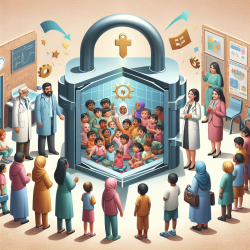The recent study titled "Exploring the use of telepractice Dohsa-hou to adults with intellectual disabilities" by Yamazaki et al. (2024) presents compelling evidence for the efficacy of telepractice in delivering therapeutic interventions. This research is particularly relevant for speech-language pathologists (SLPs) working with children in school settings through online platforms like TinyEYE. By implementing the outcomes of this research, practitioners can enhance their skills and potentially achieve better outcomes for their clients.
Key Findings of the Study
The study focused on the application of Dohsa-hou, a Japanese bodywork approach, to adults with intellectual disabilities residing in care facilities. Amid the COVID-19 pandemic, these individuals faced heightened anxiety, stress, and isolation. The researchers utilized telepractice to deliver Dohsa-hou sessions, with the following key outcomes:
- Participants exhibited a gradual positive mood change.
- There was an expressed desire among participants to continue the sessions.
- The study highlighted the potential of telepractice Dohsa-hou as a viable substitute for face-to-face sessions.
Implications for SLPs Working with Children
While the study focused on adults, the findings have significant implications for SLPs working with children. Here are some actionable steps practitioners can take:
- Adopt Telepractice Techniques: Incorporate telepractice methodologies into your sessions. The positive mood changes observed in the study suggest that similar outcomes could be achieved with children.
- Focus on Emotional Well-being: Pay attention to the emotional and psychological states of your clients. Implementing bodywork approaches like Dohsa-hou can help alleviate anxiety and stress.
- Continuous Assessment: Regularly assess the mood and engagement levels of your clients. This will help in tailoring the sessions to meet their specific needs.
- Encourage Continuity: Promote the idea of ongoing sessions. The desire for continuity expressed by the study participants indicates the importance of consistent therapeutic interventions.
Encouraging Further Research
While the study by Yamazaki et al. provides valuable insights, further research is essential to validate and expand upon these findings. Practitioners are encouraged to engage in research activities or collaborate with academic institutions to explore the following areas:
- Long-term Effects: Investigate the long-term impact of telepractice Dohsa-hou on children with intellectual disabilities.
- Comparative Studies: Conduct comparative studies between telepractice and face-to-face sessions to evaluate the efficacy of different delivery methods.
- Adaptation for Children: Explore how Dohsa-hou can be adapted specifically for children and integrated into speech-language therapy sessions.
In conclusion, the study "Exploring the use of telepractice Dohsa-hou to adults with intellectual disabilities" offers promising insights that can be leveraged by SLPs to improve their practice. By adopting telepractice techniques and focusing on the emotional well-being of clients, practitioners can create more effective and engaging therapy sessions. Further research in this area will help in refining these approaches and achieving better outcomes for children.
To read the original research paper, please follow this link: Exploring the use of telepractice Dohsa-hou to adults with intellectual disabilities.










